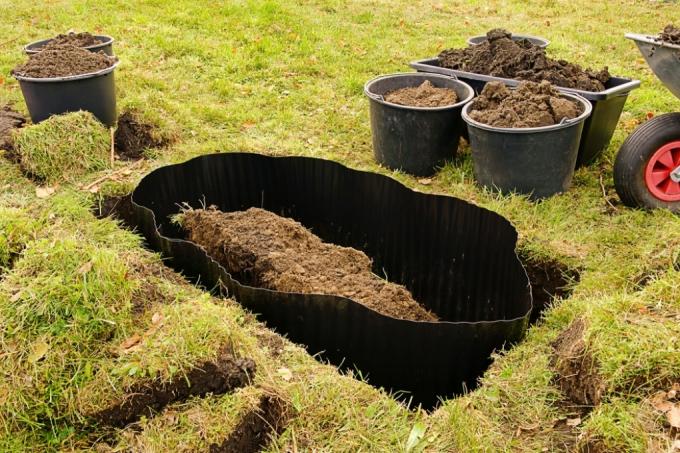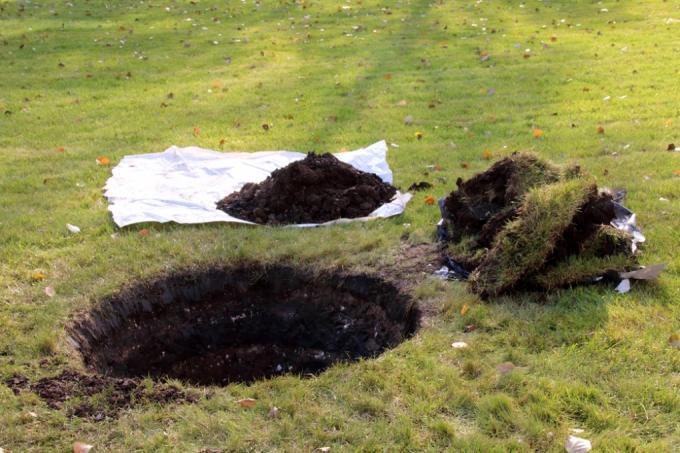the essentials in brief
- One Rhizome barrier prevents runners-forming plants from invasively spreading in the garden.
- Rhizome barriers are made of 2 mm thick HDPE polyethylene film to withstand the pressure exerted by the roots of bamboo shoots.
- Hobby gardeners can buy a rhizome barrier in specialist shops and install it themselves.
Buy Rhizome Barrier - Tips on Where to Buy and Products
Bamboo conquers its territory above and below ground. The mighty stalks stretch up to 10 meters towards the sky. Huge horizontal rhizomes spread out in all directions below the surface. To prevent bamboo roots from falling unrestrainedly over the strands, you should buy a rhizome barrier before planting and install it as a stable root barrier. The following overview summarizes which product properties must be observed and where you can get rhizome barriers of the best quality at a reasonable price:
also read
- Does the red bamboo need a rhizome barrier?
- Limit the bamboo with a rhizome barrier
- Is bamboo fargesia suitable for planting a hedge?
Rhizome barrier - fundamental product properties
- properties: frost-hardy, tear-proof, UV-resistant, rodent-stable, pollutant-free, recyclable
- material: High pressure polyethylene (HDPE), metal (galvanized)
- Dimensions: from 70 cm width and 2 mm thickness
- equipment: Locking rail
When dimensioning, please note that a rhizome barrier for bamboo must be installed at least 60-65 centimeters deep. Furthermore, the barrier should protrude 5-10 centimeters. This is undoubtedly not particularly decorative, but it is strongly advised. Flush with Garden soil the rhizomes effortlessly overcome root barriers that run along the path.

A rhizome barrier only fulfills its purpose if it is absolutely tight and ends a little above the garden soil
Sources of purchase with price
When buying a rhizome barrier for bamboo and comparable green powerhouses, the focus is on high-quality, stable quality. This requirement does not imply that you have to dig deep into your pockets to get a working root blocker. The following overview lists inexpensive sources of purchase for top quality root barriers:
- Mc-Bambus.de: Rhizome barrier made of HDPE film, 70 cm x 2 mm at a price from 7.50 EUR / m, 100 cm x 2 mm from 10.50 EUR / m
- Rhizomsperre.de: HDPE plastic sheeting, 70 cm x 2 mm at a price from 14.90 EUR / m
- Bambusbörse.de: HDPE-Root lock, 70 cm x 2 mm at a price of 66.90 EUR for 10 m, 114.90 EUR for 20 m
- Stretcher: Polypropylene root barrier, 70 cm x 2 mm at a price of EUR 26.99 for 3 m, EUR 42.99 for 5 m
- Hardware store (Obi, Hagebau, Hornbach): plastic root barrier, 70 cm x 2 mm from 11.90 EUR / m
Matching locking rails are available from EUR 27 per piece. The rails are made of weatherproof aluminum. The scope of delivery includes screws and washers made of stainless steel for secure attachment.
A metal rhizome barrier for bamboo is a considerable investment compared to plastic. For this reason, standardized offers are few and far between on the market. Dimensions of 70 cm in height, 2 mm in thickness and several meters in length are considered to be custom-made, which results in significantly higher prices. Ideally, contact a metalworking company in your area and request an individual offer.
Digression
Rhizome barrier is not mandatory for every bamboo
Installing a rhizome barrier for bamboo - instructions for beginners
Youtube
The best time to plant bamboo is in early spring. An appointment from mid / late March is ideal if you are installing a rhizome barrier beforehand or at the same time. As soon as the ground has completely thawed, you can start paving. If you missed the optimal time, put the bamboo and rhizome barrier in the garden soil in autumn. Well-considered planning and the provision of the right tools set the course for smooth work. How to do it right:
Planning, material and tool list
The informed choice of the location for a bamboo with a rhizome barrier depends on several factors. Sunny to partially shaded light conditions as well as a fresh, slightly acidic and loosely permeable soil guarantee healthy growth.
An area of at least 2 meters in diameter gives a medium-sized solitary Phyllostachys bamboo sufficient root space. In a corresponding radius, the rhizome barrier is sunk into the ground, from which the order quantity of the rolled goods is derived can be calculated: 2 m diameter of the rhizome barrier results in 6.3 m circumference plus 20 cm for overlaps and 50 cm for Waste. You can therefore buy 7 m rhizome barriers with a width of 70 cm, 90 cm or 100 cm as well as one or two matching locking rails. The following work equipment should be available on the selected day:
- Bamboo plant
- Rhizome barrier and locking bars
- spade
- cutter
- Folding rule or tape measure
- Wooden sticks, string or similar marking material
- working gloves
Ideally, use a drainage spade. A is also well suited for the excavation work spade with unwound shovel.
Install rhizome barrier - instructions

The rhizome barrier has to withstand something
Before you start installing a rhizome barrier, place the young bamboo in the container in a bucket of water. This allows the root ball to soak itself in moisture, which optimizes the starting conditions after planting. How to properly install a rhizome barrier:
- Measure and mark the area around the planting pit
- First dig a 10 cm deep furrow along the marking
- remove Mark
- Use the spade to dig a vertical trench with a depth of 60-65 cm
- Remove sharp stones and old roots
- Insert the rhizome barrier in the trench with a 5-10 cm protrusion
- Seal the beginning and end of the roll
- Fill in the trench and pound the earth firmly
- Dig a planting pit in the middle of the island, pot and plant bamboo
- Important: The bamboo root disk is 10-15 lower than the upper edge of the root barrier
When closing a rhizome barrier, act according to the motto: Double-stitched is better. To do this, let the root barrier overlap 10 to 20 centimeters. Place an aluminum rail at the beginning and at the end of the track. This trick prevents roots from growing into the overlap.
Mason buckets as a rhizome barrier alternative

Mason's buckets are an inexpensive, simple variant of the rhizome barrier
If you prefer to build a bamboo rhizome barrier yourself, the masonry bucket has proven to be an excellent alternative. In this way, you can at least put the runners-forming dwarf bamboo in its place. In order for a vat to fulfill its function as a root barrier to your complete satisfaction, important details are important. The following instructions explain, suitable for beginners, which properties characterize the ideal masonry bucket and how the installation works perfectly:
- Suitable mortar tub: from 65 cm height and 90 l capacity (to be bought at the hardware store)
- Cut out the bottom with a cutter
- Dig a planting pit for the bamboo
- Insert the bottom of the bucket so deep that the edge of the container is 5 cm above the bottom
- Fill the masonry bucket rhizome barrier halfway up with loose, nutrient-rich bamboo soil
Please plant the potted, water-soaked dwarf bamboo so deep that its root disc is a few centimeters below the edge of the tub. Press the substrate with both hands and pour plenty of water. When deciding on a masonry tub as a rhizome barrier, please consider that even the largest tubs do not offer enough root space for a majestic flat-tube bamboo. For mini bamboo, raspberry or Chinese reed, on the other hand, a mortar tub acts as an optional alternative to expensive rhizome barriers made of HDPE plastic.
Retrofitting a rhizome barrier - how does it work?
As a young plant, bamboo uses cunning and a few seemingly harmless stalks to cover up the fact that it contains a concentrated load of vigor. Within a short time, the usurers strive to subjugate the entire garden area. Then it is the ultimate railroad to rigorously curb growth. By retrofitting a rhizome barrier, you literally tackle the problem at the root.
If you want to remove firmly overgrown, lignified bamboo rhizomes, you are lost with your hoe, spade and ax. Rent a mini excavator to dig a 90-100 centimeter deep trench around the bamboo stand. In advanced growth, a depth of 70 centimeters is usually no longer sufficient for a functioning rhizome barrier. Smooth the pit walls by removing stones and cutting off old roots. Sink the root barrier in the ground as explained in the above instructions.
Rhizomes located outside the root barrier are cut through by the excavator. Of course, that does not mean the end of growth. In the following weeks, fresh stalks will sprout cheerfully, which you should cut off consistently. It takes an average of 2 to 3 years for separated rhizomes to finally capitulate and stop growing.
Tips
Look out for a bamboo without a rhizome barrier for the front yard or as a Privacy screen? Then red bamboo 'Chinese Wonder' is an excellent choice. As the botanical name Fargesia nitida suggests, the spectacular variety is one of the clump-forming bamboo species that do not allow invasive roots to grow.
Rhizome barrier compulsory - an overview of the infamous usurers

If flat tube bamboo is not contained, it will soon shoot out of the ground everywhere
Runners-forming bamboo species are not the only aspirants for a rhizome barrier. Mother nature has brought forth other plants that cause considerable headaches in the garden with their massive spread of roots. The following table names notorious usurers by name, which you should always plant with a rhizome barrier:
| Surname | botanical name | known varieties |
|---|---|---|
| Flat tube bamboo | Phyllostachys | black bamboo, giant bamboo |
| Arrow bamboo | Pseudosasa japonica | Japanese arrow bamboo |
| Dwarf bamboo | Pleioblastus pygmaeus | Disticus, Pumilus |
| Vinegar tree | Rhus typhina | Dissecta, fern frond, deer cob sumac |
| Giant Chinese reeds | Miscanthus giganteus | Aksel Olsen |
| Chinese reed | Miscanthus sinensis | Silver pen, Malepartus |
| raspberry | Rubus idaeus | Polka, Prussia II |
| Sea buckthorn | Hippophae rhamnoides | Pollmix, Leikora |
It is not a candidate for a rhizome barrier Pampas grass. The popular ornamental grass is in fact making itself unpopular as it spreads wildly in the garden. However, the invasion is due to rampant self-sowing. A pampas grass sends a myriad of seeds on its journey. You can put a stop to this bold undertaking by cutting blooming ears in good time before the feathery seed heads form.
Check the rhizome barrier regularly
The best rhizome barrier is no guarantee that bamboo or giant Chinese reeds will break out sooner or later. Expert installation is therefore not enough if you want to keep the upper hand in your garden. At least once a year, please note a meticulous on-site inspection on your schedule.
Armed with a spade, scissors or ax, cut off any runners that venture beyond the root barrier. The earlier you put a stop to the attempt to break out, the less effort it will take. As a precaution, we recommend keeping the inner edge of a rhizome 20 to 30 centimeters wide free of runners.
frequently asked Questions
What is a rhizome barrier?
Numerous invasive plants spread in the garden through a predominantly horizontal growth of strong earth sprouts, also called rhizomes. This includes various types of bamboo, as well as giant Chinese reeds, raspberry bushes and the vinegar tree. A rhizome barrier limits root growth to a defined area and prevents unbridled spread.
Where can I buy rhizome barriers?
In order for a rhizome barrier to keep bamboo in check, it depends on a high-quality, stable quality. Only high pressure polyethylene (HDPE) with a thickness of at least 2 millimeters is able to withstand the massive root pressure. The best sources of shopping for premium rhizome barriers are local specialty stores and competent online shops. What is sometimes offered in the hardware store as a rhizome barrier for bamboo or giant Chinese reeds often gives the gardener a headache in retrospect. Weed control(€ 13.47 at Amazon *) or pond liner are not suitable for withstanding the tremendous pressure of the rhizomes over the long term.
How deep do I have to build a rhizome barrier for bamboo?

A root barrier should reach at least 60cm deep
You can buy rhizome barriers in proven quality as sheet goods with a height of 70 cm. There is a good reason for that. You should install a root barrier to a depth of at least 60-65 cm. So that rhizomes of bamboo, Chinese reeds or other usury do not simply overcome the barrier above ground, a height of at least 5-10 cm above the ground is mandatory.
Can I retrofit the giant Chinese reed rhizome barrier?
Subsequent installation of a rhizome barrier is possible, but of course involves a lot of work. First of all, all roots and rhizomes must be cut through and dug up at the appropriate distance. This is exhausting because heavily lignified foothills can hardly be cut even with an ax. Then dig a 60-65 centimeter deep trench around the giant Chinese reed. Insert the rhizome barrier so that 5-10 centimeters protrude from the ground at the end. The ends of the membrane should overlap each other 10-20 centimeters and are connected with one or two aluminum rails. Finally, fill in the trench again.
How much planting area should the rhizome barrier enclose for a Phyllostachys green tube bamboo?
The following calculation has proven itself as a rule of thumb in the hobby garden: Half of the expected final height corresponds to the diameter of a rhizome barrier for bamboo. In relation to a green tube bamboo with a final height of 5 m, you should build in a rhizome barrier with a diameter of 2.50 m. This root space is sufficient for at least the first 10 years in a Central European garden.
We are planning a bamboo hedge as a privacy screen. What should you watch out for when installing a rhizome barrier?
For a bamboo hedge, don't put rhizome barriers around each individual plant. Rather, the root barrier encompasses the entire hedge. Since the bamboo plants can spread laterally within a hedge, the width can be a little narrower at 80 to 100 centimeters.
As a demarcation to the neighboring property, we would like to plant a bamboo grove. How can we prevent the roots from growing over to the neighbor?
Inquire first at the responsible public order office about the prescribed distance to the neighboring property. At this distance you can install a rhizome barrier made of stable HDPE film with a thickness of 2 mm and a depth of 70 to 100 cm. Plant the bamboo hedge at a distance of at least 50 centimeters from the root barrier. Please note that the rhizomes grow along the root barrier. This harbors the risk that the foothills at both ends can expand into the neighboring property. You should therefore return the rhizome sheet 2 to 3 meters to your property at each end of the hedge. In addition, check at least once a year whether the rhizomes remain behind the barrier.
We had to retrofit a rhizome barrier on our flat tube bamboo. Now we stand in front of a mountain of cut foothills. Where to put it?
Whether cut, stabbed or dredged. Bamboo rhizomes do not think about stopping their growth very quickly if the connection to the mother plant has been severed. For this reason, please dispose of the root remains in the garbage can. If there is not enough space, transport the rhizomes to the local landfill or composting facility. The compost heap carries the risk that you will involuntarily distribute viable root residues with the natural fertilizer in the garden.
Tips
Cutting back its stalks does not curb the urge to spread flat-tube bamboo. When concerned gardeners vigorously an invasive bamboo cut, the ornamental grass reacts with increased growth of its underground rhizomes in order to compensate for the above-ground loss. A combination of a rhizome barrier and the occasional one Clearance cut keeps growth in check.



